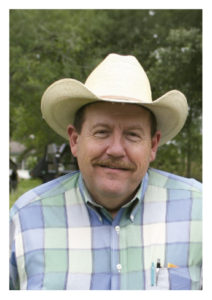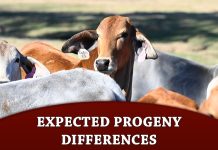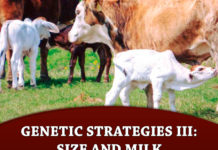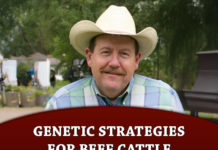
This year’s Texas A&M Beef Cattle Short Course was a win for the Brahman breed and its breeders! There were numerous speakers (beginning Sunday in the session for veterinarians) that reported on and praised positive results in their research on Brahman cattle and its genes. Brahman breeders also had booths and at least one was a session moderator and speaker! University of Florida Animal Science Department Chair Dr. John Arthington, one of the foremost beef cattle mineral nutritionists in the world discussed mineral issues in beef cattle. When asked about Brahman cattle he stated that Brahman cattle are well known for their ability to store minerals until needed, especially copper, but others as well. John is going to leave the department head position to return to the Range Cattle Research and Education Center at Ona, FL, later this year. In the first session of the Animal Breeding Session, Dr. David Riley and Dr. Andy Herring, Professors of Animal Breeding and Genetics, spoke on the history and results of the Texas A&M genomics program. The initial effort was begun in 1990 at the Texas A&M Research Station at Angleton, TX and was known as the “Angleton Project”.
The goal was to identify genetic markers in the live animal (coat color, horn/poll, growth), carcass (marbling, muscling, yield), and beef (composition, tenderness). The breeds used in this project were Bos indicus and Angus which were used to create reciprocal F1s and backcrosses (ex. reciprocal F1s: AxB and BxA; reciprocal backcrosses A x AB, Ax BA, B x AB, and B x BA to create ¾ blood cattle, sire breed listed fi rst). This project identified 11 genetic markers used in the National Genome Program and indicated breed of parent origin effects on traits. The second project was the McGregor Project at the Texas A&M McGregor Research Center. Using Angus, Brahman and Nellore F1 (Nellore were used to represent extreme diversity from Angus). Using several generations of inter se matings (at least to the sixth or F6), they were able to begin to identify small changes in several chromosomes that affected color, temperament, growth, reproduction, and stayabilty. Currently the project is studying genomic heterosis using Angus and Brahman (straight breeds and ¼, ½, and 3/4 crosses) on cow reproduction, stayabilty, and birth weight. The goal is to identify genomic regions important for heterosis expression.
This work is also being conducted at the US Meat Animal Research Center in Clay Center, NE. Dr. Raluca Mateescu, Professor of Genetics at the UF was the next speaker. I first met Dr. Mateescu at the 2018 Brahman International Field Day in Floresville, TX. I think it was hosted by the South Texas Brahman Association and they had a tremendous response! Raluca talked about her meat quality and composition work in Brahman cattle and her heat tolerance research. It was excellent! Raluca is retiring so I wanted her to discuss research in Brahmans at the UF, which she did. Dr. Mauricio Elzo began the multibreed herd (Angus and Brahman) in 1987 to reflect the cattle raised in FL which Raluca has done most of her work, but she began the Florida Brahman Genomic Selection in 2017 with 8 Florida Brahman breeders to evaluate tenderness, marbling, and reproductive tract scores. She has created a huge tissue repository (over 6,000 samples) and is evaluating over 20 production traits. Her research covers meat quality, healthfulness, thermoregulation, and heterosis (traditional and genomic).
Her research (which is published) has shown that Brahman beef is tender and healthy, containing higher levels of many minerals, and higher levels of omega-3 fatty acids and healthier fats. She has been an outspoken advocate of the Brahman breed. The next speaker was Dr. Todd Thrift. Todd is a Professor of Cow Calf Management at UF and led me to quip that this was the Texas A&M – University of Florida Beef Cattle Short Course! Todd and I go way back, he was the Beef Cattle Specialist at the Texas A&M Research and Extension Center in Overton, TX over 25 years ago. Todd humorously entitled his presentation on bull selection “What Don’t You Want? – Considerations in bull selection”. It was sort of a play on words but an effective one. I want to switch gears here and cover the General Session, specifi cally the New World Screw Worm panel. I wish they would not call it the New World Screwworm; it makes people think that it is “new”, it is not.
The ‘new’ is for the New World (the Western Hemisphere). There is actually an “Old World Screw Worm” that is a different species but only found in Africa and parts of Eurasia. The panel was led by Dr. Ron Gill, an excellent Extension Beef Cattle Specialist and rancher in his own right, with Jim McAdams, a well-known Central Texas rancher with NWS experience, Dr. Alberto Baunet, a Mexican Brahman breeder with vast experience in the current outbreak, and myself. I am not sure why I was there but once selected, I asked Dr. Banuet to come and be on the panel. We were asked to relate our experiences and then answered some audience questions and the entire panel was livestreamed by The Brahman Journal on their Facebook page. Dr. Banuet also presented at the Purebred Session the next day and the video can be found at https://www.facebook.com/share/v/1S8m3sTTpX/ (Use QR codes below to easily navigate to the FB livestreams.)
The main take home is that the NWS (at this writing in early August) is still less than 400 miles away but there seems to be little communication between the two countries with the most to lose. I understand that once the fly arrives in the US, it is a foreign animal disease, and USDA/APHIS will be in charge (similar to the Cattle Fever Tick Eradication Program we have been in since the 1940s). Producer groups have begun to form alliances to promote education and awareness of the NWS and at least one state, AZ, has begun to hand out surveillance materials. FDA has not listed any products to eliminate the screwworm infestations on animals, any treatments prescribed by your veterinarian will be off label and require a RX (and a valid veterinary client patient relationship). I know you want the macrocyclic lactones (avermectins) to work, but they do not. There are no vaccines, the only treatment at present will be to remove the larvae and treat the wound with antibiotics (none are currently approved either). The best management is to be vigilant for infections, report them (send a sample of larvae), and treat them promptly. I hope I am wrong but the lack of information about what is being done is troubling.





















